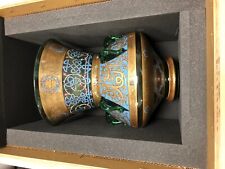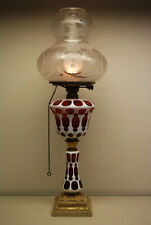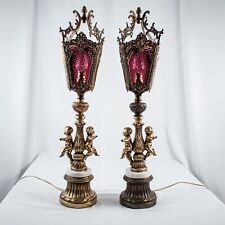Large Glass Museum Vase Enameled Brocard, Moser, Bohemian Art

When you click on links to various merchants on this site and make a purchase, this can result in this site earning a commission. Affiliate programs and affiliations include, but are not limited to, the eBay Partner Network.
Large Glass Museum Vase Enameled Brocard, Moser, Bohemian Art:
$126000.00
Extremely Important large Enameled Vase
Each of waisted globular form of turquoise tint with wide flared neck, the sides applied with six suspension loops, enamelled in opaque turquoise, gold, yellow, amber, green, red, and white with additional gilt, with thuluth inscriptions on the body and neck, blazons in roundels depicting a bands of scroll, floral rosettes and foliate decoration, the foot with a gilt band.
The history of glass enamel began in Egypt and Mesopotamia around 1500 BC and continued until Roman times. The technique got lost after about the second century AD to reappear in the middle of the Middle Ages among Muslim countries as well as among the Byzantines. Later in the 15th century, Germanic Europe continued enamelled glassmaking until the 18th century. In the early 19th century Ludwig Lobmeyr -J.&L Lobmeyr started making Islamic style glasswork in Austria. To the last third of the fabulous 19th century, Philippe Joseph Brocard perfected making of enamelled Mosque lamps. It was followed by some artists like Joseph-Philippe Imberton and Emile Gallé.
The vessel is made of pale glass. Before the enamels were applied, the surface was gilded; then the outline of the pattern was painted, and afterwards filled in with coloured enamels. The main decoration consists of embellished Islamic script.
In the Islamic religion, the donation of a lamp was considered an act of reverence towards God. This act is connected to a text in the Koran that says in verse 35 of the sura “The Light”: “God is the light of the heavens and the earth! His light is like a niche in which one finds a lamp. The lamp is made of glass; the glass is like a brilliant star.”
From a practical point of view, the donation of mosque lamps during mamluk period was necessarily important for lighting the interiors of mosques during the morning and evening prayers.
The origin of the production of such enameled glass lamps is tentatively attributed to the 13th century to Syrian and Egyptian artisans who excelled in the creation of colored and enameled glass. The first Islamic enameled glass appeared in Syria between the 12th and the early 13th century. This technique, which was quickly adopted by Egyptian artisans, flourished into a large and thriving industry. It remains very difficult to distinguish between Syrian and Egyptian production.
Enameled glass is a colored glass technique. When the glass has been formed and cooled, the artisan applies a mix of oil and pigment to the surface with the aid of tweezers or a brush. The object is then placed at the opening of the kiln until it reaches a low temperature that slowly reheats it. The pigments fuse together with the surface of the glass, creating a fine layer of color that is solidified by the cooling.
It was very important for kings to have their own lamps commissioned as it showed nobility, power, and also the blessings on the lamps gave spiritual power to the 19TH CENTURY
HEIGHT: 41 CM
CONDITION: EXCELLENT MINOR FADE OF ENAMEL, S. , Glass from Islamic Lands: The Al-Sabah Collection, Kuwait National Museum, New York, 2001, pp. 323-325.
For an introduction to the production of enameled glass, see: CARBONI S., Mamluk Enamelled and Gilded Glass in the Museum of Islamic Art, Quatar, London, 2003, p. 48-51, n° 7.
S.M. GOLDSTEIN, Glass from Sassanian Antecedents to European Imitations: the Nasser D. Khalili Collection of Islamic Art, vol. XV, London, 2005.
LAMM, C.J., Mittelalterliche Gläser und Steinschnittarbeiten aus dem Nahen Osten, 2 vol. Berlin, 1929-1930.
On the technique of enameled glass, see: WATSON O., Pottery and Glass: Luster and Enamel in Gilded and Enamelled Glass from the Middle East, London, 1998, pp. 15-19.
For examples of piece of this type, see: BERGMAN S.M., Ancient Glass in the Carnegie Museum of Natural History, Pittsburgh, 1980, n° 274.
CHARLESTON R. J., Masterpieces of Glass: A World History from the Corning Museum of Glass, New York, 1990, n° 33. WARD R. (ed.), Gilded and Enamelled Glass from the Middle East, London, 1998, fig. 23.5, 23.6, 25.4, 25.5, 25.6.
Inspected by NY Elizabeth sale
Actual shipping cost and packing to anywhere in the world which includes crate and insurance. Shipping Via UPS or DHL depending on destination. All sales final, Serious buyers only. Payment via Bank wire within 2 business days only. If you require insurance please let me know.
Large Glass Museum Vase Enameled Brocard, Moser, Bohemian Art:
$126000.00

Related Items:
Large Glass Museum Vase Enameled Brocard, Moser, Bohemian Art
$126000.00
ANTIQUE AESTHETIC BANQUETE BOSTON SANDWICH CUT GLASS KEROSENE WHALE OIL LAMP
$75000.00
Purple Lido Crinkle Glass Antique Cherub 2 Lantern Lamps Size 30"L x 24"D x 6"W
$75000.10







